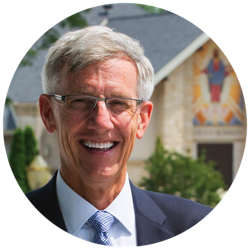
Dissertation Abstract
Specifically, this research identifies a set of 15 signal features for identification of a distinctively Roman Catholic institution of higher education within a framework for understanding institutional positioning with respect to the Roman Catholic Church from an external, or off-campus, perspective. In addition to the exploration of public documentation and the campus environment, select faculty and student leaders were interviewed at "Holy Catholic College" (a pseudonym) to understand their perspectives on the strength of Catholicity of their particular institution in the development of the framework and associated signal features.
Challenges to Institutional Catholic Identity
Demographics
The catholic, or universal, Church is open to all of mankind. Likewise, a Catholic college or university is open to students of all faith traditions. How do institutions respect other religions while retaining and remaining faithful to the tenants of the Catholic faith?
Faculty
Faculty, as holders and agents of the core institutional activity, are interacting with students regularly and become the face and voice of an institution. How committed are the faculty to the institutional mission?
Governance
Intellectual freedom has been the cornerstone of true academic freedom. How does the governance of an institution, whether by regulators, civil government, or appointed Board, impact an institution’s ability to pursue truth?
Autonomy
An institution’s ability to pursue truth and mission without interference from societal, cultural, or political forces is paramount. How does the institution handle the external pressures that are ever-present?
Leadership
Institutional leadership is responsible for setting into motion the strategic vision for the school. The strategic planning and execution on that plan, developed within the shared governance context, has lasting impacts on an institution’s ability to maintain integrity in its mission. How well does the leadership understand and implement mission into the planning process?
Students
The Catholic college serves its students. Is the school building upon the students’ faith foundation and is the impact noticed in the behaviors and activities of students?
Signal Features
Below, you can learn about the features as well as some examples of the guideposts supporting the signal feature.
Alignment
-
MaterialsCatalog(s), fliers, and campus extracurricular information explicitly highlight relationship to the Catholic Church
-
Physical SignsChapel, statues of Church figures, crucifix publicly displayed, and Catholic art
-
Campus ActivitiesStudent clubs and initiatives, commencement speakers, lecturers, and honor award winners that support the teachings of the Magisterium
-
Coursework & LecturesPhilosophy and theology courses; a faculty department or Chair of Theology; theologians with the mandatum; teachers that respect Catholic doctrine, and topics discussed during open campus lectures that include the teachings of the Magisterium
-
ServiceStudent clubs that focus particularly on the poor, underprivileged, and vulnerable members of society, with meaningful numbers of members and frequency of participation
Culture
-
Culture Gives WitnessSchool calendar acknowledges Catholic liturgical rhythm; faculty, staff, and student participation in the Sacraments; Catholic College/University (CCU) president is a Catholic
-
Campus “Way of Life”Behaviors are considerate of others; active behavior focused on the needs of others; student gatherings to help each other; faculty readily available to assist students; significant presence of Catholics in the faculty, on the staff, and in the student body; religious devotions and Catholic spirituality opportunities highlighted on student activity calendars; encouragement of students to participate in campus ministry programs
-
SacramentsOpportunities for participation in the Catholic Sacraments, particularly the Eucharist and Reconciliation, are well published and attended; opportunities for prayer and individual spiritual reflection
-
Active InvolvementExtensive student participation in activities that promote societal justice; presence of a pastoral ministry
-
CommunityPrograms and services available for the health and welfare of the community in conformance with the teachings of the Church
Engagement
-
Campus DiscussionsFrequent public discussions on theological and ethical issues
-
Presence of ChristPublic prayer for ceremonies, meetings, classes, and special events; mission statement reflects importance of Catholic Church; symbols of Christian life seen in the physical plant such as building names, statues, or infrastructure to support Catholic devotions
-
Scholarly ViewpointsCatholic teachings always presented; respectful of the rights of individuals and the community
-
Institutional HeroesThe lives of institutional role models reflect the Christian virtues that guide conduct (prudence, justice, fortitude, and temperance) in a relationship with the Holy Trinity (faith, hope, and love), such as exhibited by the Saints
-
Role of Faith & ReasonSearch for truth includes both faith and reason
